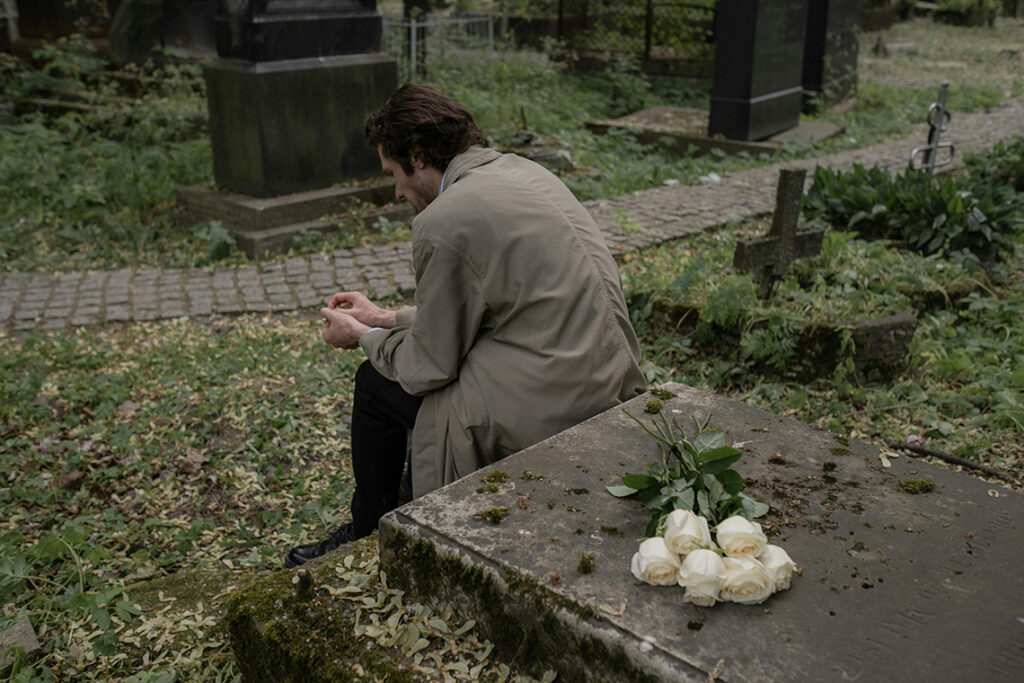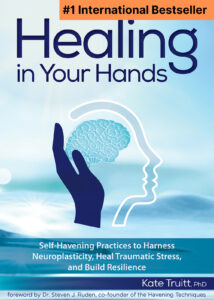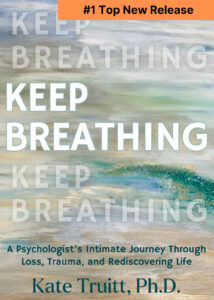Related Resources
For Dealing With Grief and Loss
• Empowering Your Grief and Loss Journey
Welcome to our transformative YouTube playlist dedicated to psychoeducation on grief, loss, and the journey through traumatic grief. At this channel, we are committed to providing you with valuable insights, empowering knowledge, and practical tools to navigate the complex terrain of emotions.
Our goal is to offer a safe space where you can explore the depths of grief and loss, guided by the expertise of Dr. Kate Truitt. As an esteemed clinical psychologist and applied neuroscientist, Dr. Truitt brings her vast experience to help you understand the intricate dynamics of these emotional landscapes.
CPR for the Amygdala – How To's and Guided Meditation:
This Playlist highlights CPR for the Amygdala, in which CPR stands for Creating Personal Resiliency. The following videos explore and teach how to use soothing self-havening touch and cognitive interventions to support you in releasing any activating moments or triggers that have been causing you continued difficulty or have been intruding into your minds. This is a powerful tool for proactively (and quickly!) stopping rumination, releasing stress, managing anxiety, stopping reactivity, and creating calm.
Neuroplasticity: How the Brain Changes Itself & How We Change It!
In this video, Dr. Kate Truitt begins by recounting that people used to believe that after age 25 our brain was like a cement block. She reminds us that our brain changes over the entirety of our lifetime due to a concept called neuroplasticity, which states that our brain is malleable and changeable. Our brain is composed of billions of neurons, each with their own thousands of relationships with other neurons. They are constantly rearranging themselves. Because of neuroplasticity, we can actually design the brain we want. We can choose to build our brain to respond the way that we want it to. She tells us that this new series will delve into neuroplasticity and help us to create sustainable change.
A CPR for the Amygdala Self Havening Meditation for Traumatic Loss
In this guided meditation, Dr. Kate Truitt explores the nuances of triggers associated with traumatic grief and PTSD. Unlike typical PTSD triggers, triggers during traumatic loss are intensified by our internal experiences and memories of the person who is no longer with us. This complex emotional landscape can evoke feelings of deep shame, remorse, and responsibility. Dr. Truitt introduces the havening touch technique, designed to recalibrate the amygdala’s interpretation of sensory triggers. Used alongside the Creating Possibilities Protocol, this transformative practice offers the potential for meaningful brain changes.
How to Rebuild Our Life After Loss
How do we move forward and rewrite our internal narratives after a loss? Join Dr. Kate Truitt in this psychoeducational video as she explores the process of reshaping our stories and finding new meaning and purpose in the face of grief. Grief is hard and complicated. It can impact everything, from how our bodies function to our ability to think clearly. When this happens, we can get stuck for a really long time. If you’re struggling with this, just remember that there’s nothing wrong with you, and this is all part of the grieving journey. Practice self-compassion and be curious about why our brain is reacting this way. In this video, Dr. Kate mentions the left/right hand journaling exercise.
Building a Resilient Brain After Loss: Tools for Long-Term Healing
By Dr. Kate Truitt
In the aftermath of loss, our brains can feel overwhelmed by grief, stress, and emotional pain. The good news is our brains are neuroplastic. It’s our brain’s remarkable ability to reorganize and form new neural connections—that comes into play as a powerful tool for healing.
Understanding Neuroplasticity and Its Role in a Grief Journey

Neuroplasticity is the brain’s inherent capacity to adapt and change throughout our lives. When we experience loss, our brain circuits linked to memories, emotions, and stress responses can become heavily activated. However, with intentional effort and practice, we can create new neural pathways that support resilience and emotional recovery. This process of rewiring our brains isn’t just a theoretical concept—it’s a scientifically proven method that allows us to reshape our emotional landscape. (For more information see my video titled, Neuroplasticity: How the Brain Changes Itself & How We Change It! which is also explained and linked in the sidebar of this article.)
For instance, consider how trauma can trap us in a cycle of negative thoughts and emotions. We can interrupt these cycles and introduce new, healthier patterns through practices like mindfulness, self-compassion, and CPR for the Amygdala—a technique designed to calm the nervous system. By repeatedly engaging in these practices, we harness neuroplasticity to diminish the hold of trauma-related neural pathways and strengthen those that foster calm, safety, and resilience.
Because of neuroplasticity, we can overcome not only the immediate shock of loss but also the long-term impacts, such as chronic stress and anxiety. Whether through structured therapeutic interventions or daily self-care routines, the intentional incorporation of neuroplasticity can empower us to heal from within, building a brain that is resilient in the face of loss and capable of thriving in the long term. I’ve highlighted this in my book, Healing in Your Hands: Self-Havening Practices to Harness Neuroplasticity, Heal Traumatic Stress, and Build Resilience.
Specific Practices to Promote Neuroplasticity
These practices create an environment within the brain that promotes healing, adaptability, and the formation of new, healthier neural pathways.
1. Mindful Breathing
Mindful breathing involves focusing your attention on the breath, observing each inhale and exhale without judgment. This practice activates the parasympathetic nervous system, reducing stress and allowing the brain to calm the amygdala, which is often hyperactive during grief.
2. CPR for the Amygdala
CPR (Creating Personal Resilience) for the Amygdala is a technique designed to rapidly reduce stress and emotional overwhelm by calming the amygdala. This process helps to prevent the amygdala from hijacking your emotional responses, allowing your thinking brain (prefrontal cortex) to remain in control. By regularly practicing CPR for the Amygdala, you can train your brain to respond to stress more effectively, fostering long-term resilience.
Learn more about this technique by watching this video on my YouTube channel which is also explained and linked in the sidebar of this article.
3. Guided Meditations
Guided meditations are structured mindfulness practices where an instructor leads you through a series of visualizations, affirmations, or breathing exercises. These meditations can be tailored to specific needs, such as dealing with grief, reducing anxiety, enhancing self-compassion, or building resilience. By listening to guided meditations regularly, you can deepen your mindfulness practice, support neuroplasticity, and create lasting changes in your brain’s emotional response patterns.
The Importance of Self-Compassion in Building Resilience

When navigating the painful journey of healing after loss, self-compassion becomes an essential tool for building resilience. Self-compassion involves treating ourselves with the same kindness, understanding, and care that we would offer to a close friend in times of suffering. This practice isn’t just about feeling better in the moment—it has profound effects on our brain’s capacity for healing, influencing neuroplasticity and helping us to recover more fully.
Self-compassion plays a crucial role in healing because it directly affects the brain’s plasticity—the ability to change and form new connections. When we practice self-compassion, we engage the brain’s soothing and safety networks, which helps to calm the amygdala (our brain’s fear center) and reduce the impact of stress. This, in turn, creates a more fertile environment for neuroplasticity, allowing us to form new, healthier neural pathways that support emotional resilience. In this How To Deal with Grief and Trauma podcast episode with Nathalie Himmelrich, we talked about the importance of gentleness and tenderness in healing from trauma, which can create space for emotional healing.
Mindfulness, in particular, helps us to stay present with our emotions without judgment, allowing us to observe our pain with a kind and understanding perspective. This mindful awareness helps to break the cycle of negative self-criticism and even self-blame that often accompanies grief, opening the door for more compassionate responses to ourselves.
By consistently practicing self-compassion, we begin to rewire our brain’s response to grief and loss. Instead of getting stuck in patterns of self-blame or despair, we can create new pathways that encourage healing, acceptance, and growth. Over time, these new patterns become stronger, helping us to build a resilient brain that can navigate future challenges with greater ease.
Building New Connections: The Role of Relationships and Support Systems

Grief is a profound experience that touches every facet of our lives, and while the pain of loss can feel isolating, it’s through our relationships and support systems that we find a path toward healing. These connections aren’t just emotionally supportive; they play a vital role in how our brains process and recover from grief. By making room for meaningful connections and seeking community support, we can build resilience that helps us navigate the challenging journey of loss.
Our brains are wired for connection. When we engage in positive social interactions, our bodies release oxytocin, often referred to as the “bonding hormone.” This powerful chemical not only enhances feelings of love and trust but also reduces stress and anxiety. The presence of supportive relationships during times of grief can buffer the impact of stress on the brain, allowing us to process emotions more effectively and reduce the risk of long-term mental health issues.
Neuroscience reveals that the brain’s capacity for resilience is greatly enhanced through social connections. For example, engaging with others in meaningful conversations, participating in community activities, or simply spending time with loved ones activates neural pathways associated with safety and security. This activation helps to counterbalance the overwhelming emotions that come with grief, enabling the brain to recover and adapt more effectively. It’s why I’ve included this as one of the main themes of my book, Keep Breathing: A Psychologist’s Intimate Journey Through Loss, Trauma, and Rediscovering Life.
Moreover, when we feel connected to others, our brain’s amygdala—the area responsible for processing fear and threat—is less likely to be hyperactive. This decrease in amygdala activity can prevent the brain from becoming stuck in a state of heightened stress, overwhelming sadness, and ruminating thoughts, which are often experienced during periods of intense grief. By reducing the brain’s stress response, positive relationships enable us to move from merely surviving our grief to actively healing.
Here are some tips for building meaningful connections during the healing process:
- Reach Out to Loved Ones: Don’t hesitate to lean on your family and friends during your grieving process. Even simple acts like sharing a meal or taking a walk together can provide comfort and connection.
- Join a Support Group: Finding a community of individuals who have experienced similar losses can offer a sense of understanding and validation. Support groups, whether in-person or online, provide a safe space to express your emotions and learn from others’ experiences.
- Practice Self-Compassion: Grief can sometimes lead to feelings of guilt or shame. It’s important to treat yourself with the same kindness and understanding that you would offer to a friend.
- Engage in Community Activities: Volunteering or participating in community events can help you feel more connected and purposeful, which can be incredibly healing. These activities also offer opportunities to build new relationships and reinforce existing ones.
- Set Boundaries: While connection is essential, setting boundaries that protect your energy and emotional well-being is equally important. Be honest with yourself and others about what you need during your healing process.
If you or someone you know is going through grief, please reach out to me and my team at The Trauma Counseling Center of Los Angeles and/or Dr. Kate Truitt and Associates.
For mental health professionals and clinicians working, we have an on-demand course on The Traumatic Grief Neuroplasticity Toolkit: Harnessing Neuroscience to Guide Recovery and Finding New Meaning after Loss.
Creating a Personalized Resilience-Building Plan
Having a personalized resilience-building plan can be a powerful tool for long-term recovery when navigating grief and your healing journey. That’s why it’s important to have a roadmap on how you can nurture and care for your emotional and mental well-being.
Start by identifying what your mind, body, and soul need most right now. Whether it’s seeking therapy, engaging in mindful practices, or setting aside time for rest, choose actions that resonate with your unique journey. These steps should be achievable and kind to yourself, providing a gentle but steady path forward. In this psychoeducational video (which is also explained and linked in the sidebar of this article), learn how we can move forward and find new purpose and meaning in the face of grief.
Incorporate daily practices for neuroplasticity, including the ones mentioned previously on this blog, as well as meditation, journaling, or even learning something new—can support your brain in adapting and healing. Balancing these with emotional recovery practices, such as connecting with loved ones or expressing your feelings creatively, ensures a holistic approach to healing.
Please remember that you’re not alone in this. Healing is not a linear journey. It allows you to see how far you’ve come, even when the steps feel small. Celebrate these moments of growth and healing, no matter how minor they may seem. Each one is a testament to your resilience and a reminder that you are actively participating in your healing.
Resources
- American Psychological Association. (2023, July 19). How grieving changes your brain [Audio podcast episode]. In Speaking of Psychology. https://www.apa.org/news/podcasts/speaking-of-psychology/grieving-changes-brain
- National Institutes of Health. (2017, October). Coping with grief. NIH News in Health. https://newsinhealth.nih.gov/2017/10/coping-grief
- American Brain Foundation. (n.d.). How tragedy affects the brain. Retrieved from https://www.americanbrainfoundation.org/how-tragedy-affects-the-brain/













